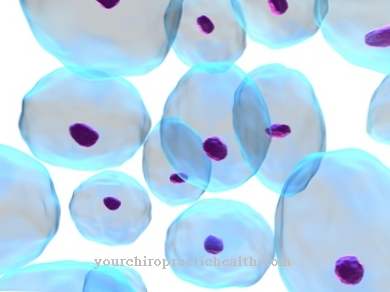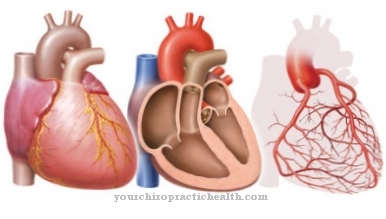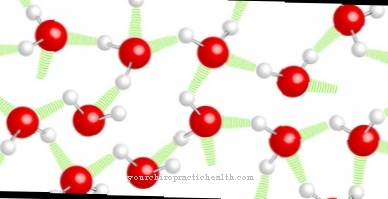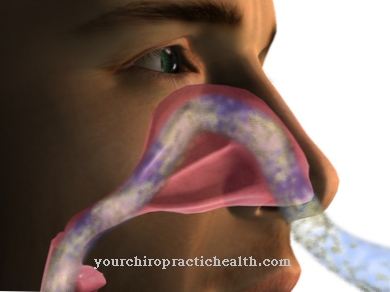Under the term Catabolism all metabolic processes of the body are summarized, in the course of which the complex and sometimes high-molecular proteins, carbohydrates (polysaccharides) and fats are broken down into their simpler components - mostly with energy production. The individual building blocks are then available for the synthesis of the new substances required or are further broken down and excreted.
What is catabolism?

Metabolic processes that involve the breakdown of higher molecular weight substances to lower molecular weight substances are summarized under the term catabolism. These are usually multi-stage or multi-stage processes that are mostly exothermic.
The exothermic processes are controlled biocatalytically by enzymes, vitamins and hormones in order to be able to use the released energy for the body in the form of heat or chemical energy for the endothermic build-up of substances and to protect the immediate reaction environment from burns.
The body is dependent on energy production through catabolic metabolic processes, since, in contrast to green plants, it cannot carry out photosynthesis, on whose energy production and conversion into storable chemical energy all aerobic life is based.
Carbohydrates are broken down through the use of enzymes such as amylases and saccharases to form simple sugars and even glucose. The glucose can in turn be metabolized into carbon dioxide and water for the construction of new substances or further with energy production and excreted.
Protein and fat catabolism include similar breakdown processes. High molecular weight proteins are broken down into low molecular weight peptides until individual amino acids are obtained, which are further metabolized or used to build new proteins. Fats are broken down into fatty acids and then metabolized in a similar way to carbohydrates.
Function & task
Catabolism or catabolic metabolic processes fulfill four different main tasks and functions. The first main task is to generate energy in the form of usable heat or in the form of chemical energy for the subsequent use of heat or for the endothermic build-up of new substances required. If necessary, for example, the starch formed and stored via anabolic processes is converted back into glucose via catabolic conversions and made available to the cell.
Another task is to provide the breakdown products of proteins, carbohydrates and fats, which are required for anabolism (building metabolism), for the construction of new substances. It is a kind of recycling process, also known as a salvage pathway. An essential advantage is that it is energetically less expensive to assemble proteins, enzymes and hormones from recycled larger pieces than to synthesize them from the ground up from the required molecules with an appropriate supply of energy.
The third task, while also very important, could also be seen as a useful companion. The importance of many complex substances such as enzymes, hormones and vitamins lies in their bioactivity and catalytic effect. If a particular enzyme or hormone has served its purpose, it must be made inactive or replaced by its counterpart. Catabolism plays an important role here. As soon as a hormone, enzyme or vitamin is metabolized, i.e. catabolized, its bioactivity is suddenly interrupted. A similar process can occur with certain toxins, which lose their toxic effect through catabolism and can be further metabolized as degradation products of the toxin in order to be used as residues, e.g. B. to be excreted through the kidneys.
As part of the fourth task of catabolism, the body is able to use metabolic processes to break down the body's own proteins, fats and carbohydrates for the purpose of energy production or to use them to obtain certain amino acids or other urgently needed compounds. The body can survive several days without food and is able to break down body tissue and build it up elsewhere as required.
In order to avoid conflicts within a cell, catabolic and anabolic metabolic processes do not run simultaneously, but always separate from one another. Enzymes of catabolic processes inhibit the enzymes of anabolic processes and vice versa. Certain phosphatases can reverse the direction of metabolism, either anabolic or catabolic.
Illnesses & ailments
Catabolism comprises a multitude of enzymatically catalytic, biochemical metabolic processes, which are always interrelated with their counterpart, anabolism. Complaints and problems are therefore less the result of an overall disorder, but rather as a rule of the lack of certain enzymes or their biochemical ineffectiveness due to a genetic defect that leads to an incorrect synthesis of the enzyme.
Basically, however, there are situations that mainly lead to a catabolic metabolism, as body substances have to be broken down more to prevent poisoning or flooding with substances that are harmful to the body. Such situations arise z. B. in muscle paralysis, heart attack, stroke and other types of atrophy.
Disorders of the catabolic metabolism can be present in the carbohydrate metabolism, in the protein metabolism and in the fat metabolism and lead to mild to serious complaints and diseases. The metabolic disease diabetes is caused by a lack of insulin or by resistance to the effectiveness of insulin and can lead to serious acute conditions. As a result of malnutrition, which for example contains too little protein and does not provide an adequate supply of essential amino acids, the body increasingly switches to catabolic metabolism, mobilizes all available energy reserves and gradually breaks down body substances in order to be able to provide the body with energy. In order to attack the body's own reserves as little as possible, the body switches to a kind of energy-saving mode at the same time. Brain performance slows down and physical performance is much more difficult.













.jpg)

.jpg)
.jpg)











.jpg)